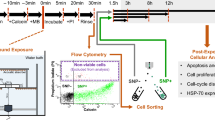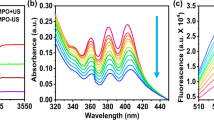Abstract
The generation of singlet oxygen (1O2) by sonicating a water-soluble complex of fullerene/poly(2-methacryloyloxyethyl phosphorylcholine) (C60/PMPC) was investigated for sonodynamic therapy (SDT). The effect of sonication time and the solubilized concentration of water-soluble fullerene C60 on the amount of generated 1O2 was studied. Singlet oxygen sensor green was used to confirm the generation of 1O2. 1O2 was generated from C60/PMPC under ultrasonic irradiation, and the amount of 1O2 increased with increasing solubilized C60 concentration and irradiation time. In cell viability tests, after 3 h of incubation, the cell viabilities were 10 and 84% in the presence of C60/PMPC with and without sonication, respectively. This result suggests that C60/PMPC shows a sonodynamic effect, which demonstrates its potential application in SDT.
This is a preview of subscription content, access via your institution
Access options
Subscribe to this journal
Receive 12 print issues and online access
$259.00 per year
only $21.58 per issue
Buy this article
- Purchase on Springer Link
- Instant access to full article PDF
Prices may be subject to local taxes which are calculated during checkout







Similar content being viewed by others
References
You Y. Chemical tools for the generation and detection of singlet oxygen. Org Biomol Chem. 2018;16:4044–60.
Yang H, Villani RM, Wang H, Simpson MJ, Roberts MS, Tang M, et al. The role of cellular reactive oxygen species in cancer chemotherapy. J Exp Clin Cancer Res. 2018;37:018–0909.
Timoshenko V. Singlet oxygen generation and detection for biomedical applications. In: Baraton M-I, editor. Sensors for environment, health and security. Dordrecht: Springer; 2009. p. 295–309.
Lv W, Xia H, Zhang KY, Chen Z, Liu S, Huang W, et al. Photothermal-triggered release of singlet oxygen from an endoperoxide-containing polymeric carrier for killing cancer cells. Mater Horiz. 2017;4:1185–9.
DeRosa MC, Crutchley RJ. Photosensitized singlet oxygen and its applications. Coord Chem Rev. 2002;233-234:351–71.
Sun D, Pang X, Cheng Y, Ming J, Xiang S, Zhang C, et al. Ultrasound-switchable nanozyme augments sonodynamic therapy against multidrug-resistant bacterial infection. ACS Nano. 2020;14:2063–76.
Harada A, Ono M, Yuba E, Kono K. Titanium dioxide nanoparticle-entrapped polyion complex micelles generate singlet oxygen in the cells by ultrasound irradiation for sonodynamic therapy. Biomater Sci. 2013;1:65–73.
Costley D, Nesbitt H, Ternan N, Dooley J, Huang YY, Hamblin MR, et al. Sonodynamic inactivation of Gram-positive and Gram-negative bacteria using a Rose Bengal-antimicrobial peptide conjugate. Int J Antimicrob Agents. 2017;49:31–6.
Redmond RW, Gamlin JN. A compilation of singlet oxygen yields from biologically relevant molecules. Photochem Photobiol. 1999;70:391–475.
Fan J, Fang G, Zeng F, Wang X, Wu S. Water-dispersible fullerene aggregates as a targeted anticancer prodrug with both chemo- and photodynamic therapeutic actions. Small. 2013;9:613–21.
Detrembleur C, Stoilova O, Bryaskova R, Debuigne A, Mouithys-Mickalad A, Jérôme R. Preparation of well-defined PVOH/C60 nanohybrids by cobalt-mediated radical polymerization of vinyl acetate. Macromol Rapid Commun. 2006;27:498–504.
Sun M, Kiourti A, Wang H, Zhao S, Zhao G, Lu X, et al. Enhanced microwave hyperthermia of cancer cells with fullerene. Mol Pharmaceutics. 2016;13:2184–92.
Wang S, Gao R, Zhou F, Selke M. Nanomaterials and singlet oxygen photosensitizers: potential applications in photodynamic therapy. J Mater Chem. 2004;14:487–93.
Guldi DM, Prato M. Excited-state properties of C60 fullerene derivatives. Acc Chem Res. 2000;33:695–703.
Hoebeke M, Damoiseau X. Determination of the singlet oxygen quantum yield of bacteriochlorin a: a comparative study in phosphate buffer and aqueous dispersion of dimiristoyl-l-α-phosphatidylcholine liposomes. Photochem Photobio Sci. 2002;1:283–7.
Nishiyama N, Morimoto Y, Jang WD, Kataoka K. Design and development of dendrimer photosensitizer-incorporated polymeric micelles for enhanced photodynamic therapy. Adv Drug Deliv Rev. 2009;61:327–38.
Zhao Y, Farrer NJ, Li H, Butler JS, McQuitty RJ, Habtemariam A, et al. De novo generation of singlet oxygen and ammine ligands by photoactivation of a platinum anticancer complex. Angew Chem Int Ed. 2013;52:13633–7.
Pan X, Wang H, Wang S, Sun X, Wang L, Wang W, et al. Sonodynamic therapy (SDT): a novel strategy for cancer nanotheranostics. Sci China Life Sci. 2018;61:415–26.
Yumita N, Iwase Y, Imaizumi T, Sakurazawa A, Kaya Y, Nishi K, et al. Sonodynamically-induced anticancer effects by functionalized fullerenes. Anticancer Res. 2013;33:3145–51.
Costley D, Mc Ewan C, Fowley C, McHale AP, Atchison J, Nomikou N, et al. Treating cancer with sonodynamic therapy: a review. Int J Hyperth. 2015;31:107–17.
Wan GY, Liu Y, Chen BW, Liu YY, Wang YS, Zhang N. Recent advances of sonodynamic therapy in cancer treatment. Cancer Biol Med. 2016;13:325–38.
Todorović Marković B, Jokanović V, Jovanović S, Kleut D, Dramićanin M, Marković Z. Surface chemical modification of fullerene by mechanochemical treatment. Appl Surf Sci. 2009;255:7537–41.
Andrievsky GV, Kosevich MV, Vovk OM, Shelkovsky VS, Vashchenko LA. On the production of an aqueous colloidal solution of fullerenes. J Chem Soc Chem Comm. 1995:1281–82.
Brant JA, Labille J, Bottero J-Y, Wiesner MR. Characterizing the impact of preparation method on fullerene cluster structure and chemistry. Langmuir. 2006;22:3878–85.
Dhawan A, Taurozzi JS, Pandey AK, Shan W, Miller SM, Hashsham SA, et al. Stable colloidal dispersions of C60 fullerenes in water: evidence for genotoxicity. Environ Sci Technol. 2006;40:7394–401.
Hungerbuehler H, Guldi DM, Asmus KD. Incorporation of C60 into artificial lipid membranes. J Am Chem Soc. 1993;115:3386–7.
Andersson T, Nilsson K, Sundahl M, Westman G, Wennerström O. C60 embedded in γ-cyclodextrin: a water-soluble fullerene. J Chem Soc Chem Commun. 1992;8:604–6.
Yamakoshi YN, Yagami T, Fukuhara K, Sueyoshi S, Miyata N. Solubilization of fullerenes into water with polyvinylpyrrolidone applicable to biological tests. J Chem Soc Chem Commun. 1994:517–8.
Ohata T, Ishihara K, Iwasaki Y, Sangsuwan A, Fujii S, Sakurai K, et al. Water-soluble complex formation of fullerenes with a biocompatible polymer. Polym J. 2016;48:999–1005.
Lee AR. Phospholipid polymer, 2-methacryloyloxyethyl phosphorylcholine and its skin barrier function. Arch Pharm Res. 2004;27:1177–82.
Iwasaki Y, Ishihara K. Cell membrane-inspired phospholipid polymers for developing medical devices with excellent biointerfaces. Sci Technol Adv Mater. 2012;13:1468–6996.
Yudasaka M, Yomogida Y, Zhang M, Tanaka T, Nakahara M, Kobayashi N, et al. Near-infrared photoluminescent carbon nanotubes for imaging of brown fat. Sci Rep. 2017;7:44760.
Xu FM, Xu JP, Ji J, Shen JC. A novel biomimetic polymer as amphiphilic surfactant for soluble and biocompatible carbon nanotubes (CNTs). Colloids Surf B Biointerfaces. 2008;67:67–72.
Ishihara K. Blood-compatible surfaces with phosphorylcholine-based polymers for cardiovascular medical devices. Langmuir. 2019;35:1778–87.
Ishihara K, Mu M, Konno T. Water-soluble and amphiphilic phospholipid copolymers having 2-methacryloyloxyethyl phosphorylcholine units for the solubilization of bioactive compounds. J Biomater Sci Polym Ed. 2018;29:844–62.
Ishihara K. Revolutionary advances in 2-methacryloyloxyethyl phosphorylcholine polymers as biomaterials. J Biomed Mater Res Part A. 2019;107A:933–43.
Gollmer A, Arnbjerg J, Blaikie FH, Pedersen BW, Breitenbach T, Daasbjerg K, et al. Singlet Oxygen Sensor Green®: photochemical behavior in solution and in a mammalian cell. Photochem Photobiol. 2011;87:671–9.
Mitsukami Y, Donovan MS, Lowe AB, McCormick CL. Water-soluble polymers. 81. Direct synthesis of hydrophilic styrenic-based homopolymers and block copolymers in aqueous solution via RAFT. Macromolecules. 2001;34:2248–56.
Takahashi T, Kono K, Itoh T, Emi N, Takagishi T. Synthesis of novel cationic lipids having polyamidoamine dendrons and their transfection activity. Bioconjugate Chem. 2003;14:764–73.
Cabral H, Matsumoto Y, Mizuno K, Chen Q, Murakami M, Kimura M, et al. Accumulation of sub-100 nm polymeric micelles in poorly permeable tumours depends on size. Nat Nanotechnol. 2011;6:815–23.
Adolphi U, Kulicke W-M. Coil dimensions and conformation of macromolecules in aqueous media from flow field-flow fractionation/multi-angle laser light scattering illustrated by studies on pullulan. Polymer. 1997;38:1513–9.
Bruns W. The second osmotic virial coefficient of polymer solutions. Macromolecules. 1996;29:2641–3.
Matsuda Y, Kobayashi M, Annaka M, Ishihara K, Takahara A. Dimensions of a free linear polymer and polymer immobilized on silica nanoparticles of a zwitterionic polymer in aqueous solutions with various ionic strengths. Langmuir. 2008;24:8772–8.
Giacomelli C, Le Men L, Borsali R, Lai-Kee-Him J, Brisson A, Armes SP, et al. Phosphorylcholine-based pH-responsive diblock copolymer micelles as drug delivery vehicles: light scattering, electron microscopy, and fluorescence experiments. Biomacromolecules. 2006;7:817–28.
Acknowledgements
This work was funded by a Grant-in-Aid for Scientific Research (17H03071) from the Japan Society for the Promotion of Science (JSPS), the JSPS Bilateral Joint Research Projects (JPJSBP120203509), and the Cooperative Research Program of “Network Joint Research Center for Materials and Devices” (20204034).
Author information
Authors and Affiliations
Corresponding author
Ethics declarations
Conflict of interest
The authors declare that they have no conflict of interest.
Additional information
Publisher’s note Springer Nature remains neutral with regard to jurisdictional claims in published maps and institutional affiliations.
Supplementary information
Rights and permissions
About this article
Cite this article
Nguyen, T.L., Katayama, R., Kojima, C. et al. Singlet oxygen generation by sonication using a water-soluble fullerene (C60) complex: a potential application for sonodynamic therapy. Polym J 52, 1387–1394 (2020). https://doi.org/10.1038/s41428-020-0390-1
Received:
Revised:
Accepted:
Published:
Issue Date:
DOI: https://doi.org/10.1038/s41428-020-0390-1



